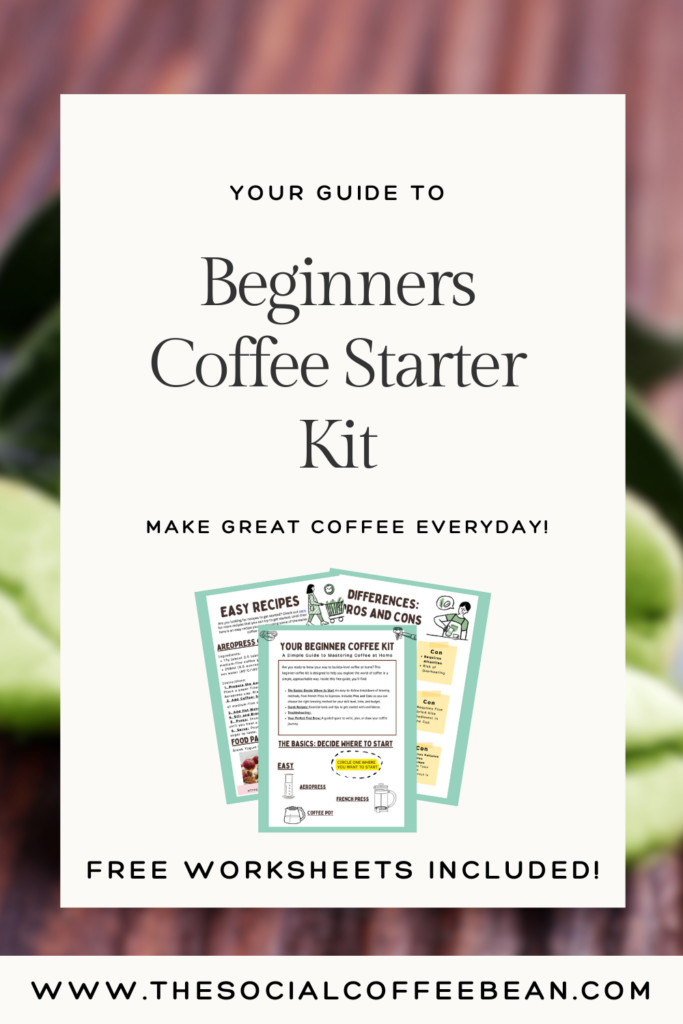
Welcome to Your Coffee Journey!
Do you dream of creating the perfect morning coffee routine where you enjoy great coffee everyday— but do you feel unsure where to begin? Starting out can feel overwhelming, but the good news is, I am here to tell you that you don’t need expensive equipment or tons of coffee knowledge to make great coffee. Just start with my beginner’s guide to making coffee at home.
In this post, I’ll share free, easy-to-use guides and guidance that will help you start your journey toward being a confident at-home barista. Starting today, you’ll have about everything you need to get started. Understand how to choose the right machine for you, and let’s help you brew like a pro!
Coffee Starter #1: Learn this Basic Coffee Knowledge
Here’s a short-version of The Beginner’s Coffee Glossary to get you started:
General Coffee Terminology:
- Coffee-to-Water Ratio: The proportion of coffee grounds to water, typically measured in grams or tablespoons. A common starting point is 1:16—1 gram of coffee for every 16 grams of water. Think of it as following a recipe for consistent flavor.
- Grind Size: Refers to the coarseness or fineness of coffee grounds. A simple analogy: coarse grind = sea salt, medium grind = sand, fine grind = powdered sugar.
- Brew Strength: The intensity of your coffee, often adjustable on machines. Think of it as the difference between light tea and dark, bold espresso.
Related Article: What Kind of Coffee Is Best for Beginners? Simple Options to Try First.
Types of Coffee Makers:
- Drip Coffee: A brewing method where water drips through coffee grounds in a filter, typically in a drip coffee maker.
- French Press: A manual brewing device that steeps coffee grounds in water before pressing them through a mesh filters
- Pour-Over: A manual brewing method where water is poured over coffee grounds in a filter, typically using a dripper. This allows for more control over brewing time, water distribution, and flavor.
Types of Machines:
- Single-Serve Machine: A coffee maker that brews one cup at a time, often using pods or capsules.
- Espresso Machine: A machine that uses pressure to extract concentrated coffee shots.
- Pod Machine: A machine that use pre-packaged coffee capsules, usually referred to as pods, to make a cup of coffee.
Related Article: Espresso Machines For Easy Frothy Lattes Every Morning
Remember, you don’t need to master every term overnight. This is only a small step in the beginner’s guide to making coffee at home. We all start the basics and build out knowledge as we experiment with brewing.
Coffee Starter #2: How to Choose the Right Coffee Machine
Here’s a simple checklist to guide your decision:
1. How much coffee do you drink daily?
- For a single cup: A pod machine like a Keurig or Nespresso is ideal for those who only need one cup at a time, offering convenience and minimal waste.
- For multiple cups: A Drip Coffee Maker or French press is more practical. These options can brew several servings in one go, making them perfect for bigger households or heavy coffee drinkers.
2. What type of coffee do you enjoy most?
- Lattes and Cappuccinos: If you love creamy, frothy drinks, opt for a machine with a built-in milk frother, like an espresso machine or a pod system that offers specialty drinks.
- Black coffee: If you prefer the bold, straightforward taste of black coffee, consider the pros and cons of either an Aeropress, Pour Over, or a French press. Each brings out rich balanced notes giving you smooth tasting brews.
3. How much time are you willing to spend brewing?
- For quick mornings: Pod Machines and Automatic Drip Coffee Makers are the most time-efficient, delivering a fresh cup in just minutes at the push of a button.
- For a more hands-on experience: If you want coffee to be a part of your morning routine and enjoy experimenting with your own brewing process, consider a French press for its simplicity or a Pour Over for its Control. Another option for Specialty Drinks is a Manual Espresso Machine, but this will require much more practice. These options may take longer but allow for greater reward of delicious coffee!
Sign up to get your own Beginner’s Guide to Making Coffee at Home.
Coffee Starter #3: Don’t Overthink Features or Costs
Making coffee at home does not have to be complicated or expensive! Many beginners feel pressured to buy high-end machines with tons of advanced features, but the truth is, great coffee is all about simplicity.
In my Beginner Coffee Guide Kit I go over the different simple tools to make coffee like: Aeropress, French Press, Pour Over, etc. However, there are affordable coffee machines like drip coffee makers, pod machines that are really easy to make coffee in the morning.
To save money, invest in tools that fit your need:
• A $20 French press for simplicity.
• A $50 drip coffee maker for multiple cups.
• A $10 handheld frother for creamy lattes.
Need help choosing the right machine? Check out guides like 5 Easy-to-Use Coffee Makers That Simplify Brewing for First-Time Users or dive into The Best Settings for Easy Brewing at Home for tips to get started.
You can also save on accessories by using reusable filters and buying beans in bulk or through subscriptions for discounts. For better flavor with any machine, invest in a good grinder—it unlocks the full potential of affordable beans.
Recommended Grinder: Opus Conical Burr Grinder
BONUS: Coffee Starter #3.5: Why you need a good Grinder
Coffee Starter #4: How to Make Great Coffee Every Time
One of the biggest challenges for beginners is brewing coffee that tastes consistently delicious. The good news is that by focusing on three key factors, you can achieve reliable, flavorful results every time.
Key Factors for Consistency
1. Coffee-to-Water Ratio
- The right ratio is crucial for balanced flavor. Start with 1:16—1 gram of coffee for every 16 grams of water.
- Quick Reference Chart:
- 1 cup (8 oz): 2 tablespoons coffee to 1 cup water
- 2 cups (16 oz): 4 tablespoons coffee to 2 cups water
2. Grind Size
- Using the correct grind size ensures optimal extraction:

- Coarse: Resembles sea salt, ideal for French press.
- Medium: Texture like sand, perfect for drip coffee.
- Fine: Similar to powdered sugar, best for espresso.
3. Water Temperature
- Brew with water between 195°F and 205°F for the best extraction.
- Too hot can result in a burnt, bitter taste, while water that’s too cool may produce weak or flat coffee.
By paying attention to these three simple factors, you can master the art of coffee brewing without frustration. Whether you’re using a drip coffee maker, French press, or espresso machine, consistency is all about getting the basics right.
Coffee Starter #5: Bonus Troubleshooting Common Mistakes
Even with the right tools and techniques, mistakes happen. In this beginner’s guide to making coffee at home, here are quick fixes for the most common coffee issues to ensure every cup tastes its best.
1. Bitter Coffee
- Cause: This often happens when the grind size is too fine or the coffee is brewed for too long, leading to over-extraction.
- Fix: Use a coarser grind and experiment with a shorter brew time to avoid extracting too many bitter compounds.
2. Weak Coffee
- Cause: Too little coffee or too much water dilutes the flavor, making the brew taste flat or watery.
- Fix: Stick to the 1:16 coffee-to-water ratio for a balanced cup. Adjust the amount of coffee to your preference, but avoid using less than recommended.
3. Flavor Loss
- Cause: Coffee cools too quickly during brewing or serving, resulting in a lack of vibrant flavor.
- Fix: Preheat your coffee maker, French press, or mug with hot water before brewing to maintain the ideal temperature and preserve the coffee’s richness.
Troubleshooting these common issues is all about fine-tuning your process. With small adjustments, you can go from “okay” coffee to a cup that’s rich, flavorful, and satisfying every time!
Conclusion
Remember, the journey to becoming a confident home barista is about learning and experimenting. Don’t be afraid to make mistakes—they’re part of the process and often lead to the best discoveries. Start small, take it one step at a time, and enjoy the satisfaction of crafting your perfect cup.
To help you get started, download our Beginner’s Coffee Starter Kit—a free, step-by-step guide packed with brewing tips, easy recipes, and troubleshooting tricks to make your coffee journey even easier. Click below to grab your guide and take the next step toward mastering coffee at home!




